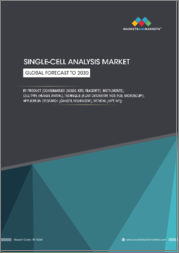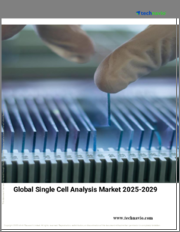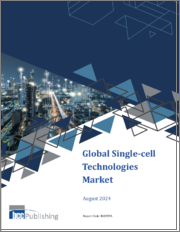
|
시장보고서
상품코드
1398862
단일세포 분석 : 기술 성장 기회Single-cell Analysis: Technology Growth Opportunities |
||||||
단일 세포 분석의 기술 발전은 새로운 진단 및 치료 기회를 촉진합니다.
단일 세포 분석은 세포 내 유전체학, 전사체학, 단백체학, 대사체학 및 기타 세포 간 상호 작용을 연구하여 이질적인 세포 집단 샘플의 상태를 진단할 수 있습니다. 종양의 미세 환경을 더 잘 이해하고 다양한 유형의 종양에 대한 새로운 지식을 바탕으로 약물을 개발하는 데 도움이 될 수 있습니다. 이 분석법을 통해 얻은 풍부한 데이터는 유전자 발현과 병리를 결정하는 다른 요인에 대한 깊은 통찰력을 제공합니다.
이 방법은 이미 존재하는 진단 및 신약개발 방법을 발전시키는 것이기 때문에 투자자와 연구기관의 관심을 받고 있지만, 기술 플랫폼의 발전으로 극복해야 할 기술적 과제와 중소기업이 제공할 수 없는 엔드투엔드 솔루션을 제공하기까지 성장한 대형 시퀀싱 기업의 독과점 등 치열한 경쟁 환경이 존재합니다.
많은 기업들이 게놈이나 전사체 수준의 단일 세포 분석을 하고 있지만, 프로테오믹스나 멀티오믹스의 단일 세포 분석을 하는 기업은 많지 않습니다. 기술의 발전은 라이브러리 준비 시 고유한 바코드 프로세스를 통한 단일 세포 분리와 같은 번거로운 과정을 피하는 데 도움이 되고 있습니다. 공간 오믹스 및 라이브 셀 시퀀싱과 같은 최신 방법도 기존의 단일 세포 분석 프로세스를 보완하고 있습니다. 이 방법의 가장 큰 과제 중 하나는 시퀀싱 결과의 데이터 분석인데, 이는 바이오인포매틱스 경험이 없어도 조작할 수 있는 클라우드 플랫폼을 통해 해결하고 있습니다. 이 분석법에서는 아직 밝혀지지 않은 주제에 대한 조사의 여지가 많기 때문에 향후 10년 동안 이 방법이 크게 성장할 것이며, 암뿐만 아니라 다른 질환의 진단 개선도 기대할 수 있습니다.
이 보고서는 이 분야의 과제, 촉진요인, 신기술 플랫폼, 성장 기회를 파악하고 성장 전망을 예측합니다. 또한, 이해관계자와 시장 진입자가 활용해야 할 주목할 만한 M&A, 자금 조달 및 파트너십을 식별하고 이해관계자 생태계에 대한 개요를 제공합니다.
목차
전략적 과제
- 왜 성장이 어려워지고 있는가?The Strategic Imperative 8(TM) : 성장을 막는 요인
- The Strategic Imperative 8(중략)
- 단일세포 분석 업계에 대한 주요 전략적 필수 요건의 영향
- Growth Pipeline Engine(TM)을 가속하는 성장 기회
- 조사 방법
조사 범위와 세분화
- 분석 배경과 범위
- 세분화
성장 기회 분석
- 성장 촉진요인
- 성장 억제요인
서론
- 단일세포 분석 도입과 그 필요성
- 단일세포 시퀀싱 프로세스 개발 타임라인
- 단일세포 분석의 용도
기술 현황
- 단일세포 분리
- 단일세포 분리 기술 - 상용화된 솔루션
- 단일세포 라이브러리 준비
- 단일세포 라이브러리 준비 - 혁신
- 단일세포 시퀀싱
- 단일세포 시퀀싱 플랫폼
- 단일세포 바이오인포매틱스
- 단일세포 분석에서 사용되는 바이오인포매틱스 툴
단일세포 분석을 강화하는 기술 지원
- 단일 세포 분석에서 AI와 ML의 영향력 확대
- 단일 세포 분석 기술을 보완하기 위해 진화하는 공간 오믹스 기술
- 단일 세포 분석의 미세 유체 기술
단일세포 분석의 최근 기술적 진보
- 세포를 손상시키지 않고 공간 정보를 제공하는 살아있는 세포 염기서열 분석 또는 시간적 분석
- 단일 세포 및 기타 기술의 조합으로 치료제 개발을 위한 심층적인 인사이트 제공
- 세포 환경과 이질성에 대한 더 나은 묘사를 제공하는 3D 게놈 기술
- 단일 세포 탐색 연구 환경
- 단일 세포 분석에 대한 대학 연구 개요
단일세포 분석 동향과 발전
- 최근 5년간 플랫폼 개발 건수 증가 추세
- 종양학을 넘어선 단일 세포 분석의 응용 분야 확대
- 새로운 발견을 통한 정밀 의학 강화를 위한 단일 세포 및 공간 분석 개선
- 이해관계자 생태계
- 단일 세포 분석 전략적 파트너십
- 자금 조달 생태계
- 단일 세포 및 공간 유전체학 분야에서 M&A를 주도하는 통합 솔루션 제공업체들
- 단일 세포 분석에 대한 특허 출원 및 보조금 꾸준히 증가 추세
- 단일 세포 분석 이해관계자 생태계 환경
성장 기회
- 성장 기회 1 : 단일 세포 분리 및 라이브러리 준비의 발전으로 전반적인 워크플로우 개선
- 성장 기회 2 : 정밀 종양학을 넘어 단일 세포 분석의 적용 가능성 확대
- 성장 기회 3 : 시퀀싱 데이터의 신속하고 의미 있는 통찰력을 위한 단일 세포 데이터 과학의 개선
부록
- 기술 성숙도(TRL) : 설명
다음 단계
LSH 24.01.04Technological advancements in single-cell analysis propel new diagnostic and therapeutic opportunities.
Single-cell analysis can diagnose a condition in heterogenous cell population samples by studying genomics, transcriptomics, proteomics, metabolomics, and other cellular interactions in cells. It helps to understand a tumor microenvironment better and develop drugs based on newly uncovered knowledge of various types of tumors. The rich data provided through this method of analysis gives in-depth insight into gene expression and other factors determining a pathological condition.
As this method is an advancement to already existing methods of diagnosis and drug discovery, it is gaining the attention of investors and research institutions, although there are a few challenges in terms of technology (which must be navigated through advancements in technology platforms) and the monopoly of large sequencing companies that have grown to provide end-to-end solutions that cannot be provided by small and mid-sized companies, creating an intensely competitive environment.
Many companies perform single-cell analysis at the genomic and transcriptomic levels; however, only a few do the same in proteomic and multi-omics single-cell resolution. Technology advancements are helping to bypass tedious processes, such as single-cell separation through a unique barcoding process during library preparation. Modern methods, including spatial omics and live-cell sequencing, are also complementing the existing single-cell analysis process. One of the major challenges in this method is the data analysis of sequenced results, which is being tackled through cloud platforms that operate without the need for prior bioinformatics experience. There is significant scope for research on topics that are underexplored in this method of analysis, which ensures good growth of this technique in the next decade and promises improved diagnosis not only for cancer but also for other diseases.
This study identifies the challenges, drivers, new technology platforms, and growth opportunities in this space and foresees a growth outlook. It also provides an overview of the stakeholder ecosystem, identifying notable mergers and acquisitions, funding, and partnerships for stakeholders and market participants to leverage.
Table of Contents
Strategic Imperatives
- Why Is It Increasingly Difficult to Grow?The Strategic Imperative 8™: Factors Creating Pressure on Growth
- The Strategic Imperative 8™
- The Impact of the Top 3 Strategic Imperatives on the Single-cell Analysis Industry
- Growth Opportunities Fuel the Growth Pipeline Engine™
- Research Methodology
Scope and Segmentation
- Context and Scope of Analysis
- Segmentation
Growth Opportunity Analysis
- Growth Drivers
- Growth Restraints
Introduction
- Introduction to Single-cell Analysis and the Need for It
- Single-cell Sequencing Process Development Time Line
- Single-cell Analysis Applications
Technology Snapshot
- Single-cell Isolation
- Single-cell Isolation Technologies-Commercialized Solutions
- Single-cell Library Preparation
- Single-cell Library Preparation-Innovation
- Single-cell Sequencing
- Single-cell Sequencing Platforms
- Single-cell Bioinformatics
- Bioinformatics Tools Used in Single-cell Analysis
Technology Enablers Bolstering Single-cell Analysis
- Growing Influence of AI and ML in Single-cell Analysis
- Spatial Omics Technologies Evolving to Compliment Single-cell Analysis Technology
- Microfluidic Technologies in Single-cell Analysis
Recent Technological Advancements in Single-cell Analysis
- Live-cell Sequencing or Temporal Analysis Providing Spatial Information Without Damaging Cells
- A Combination of Single-cell and Other Technologies Providing Deeper Insights for Therapy Development
- 3D Genome Technologies Offering a Better Depiction of the Cell Environment and Its Heterogeneity
- Single-cell Exploratory Research Landscape
- Snapshot of University Research in Single-cell Analysis
Trends and Developments in Single-cell Analysis
- Increasing Number of Platform Developments in the Last 5 Years
- Applications of Single-cell Analysis to Expand Beyond Oncology
- Improved Single-cell and Spatial Analysis to Strengthen Precision Medicine Through New Discoveries
- Stakeholder Ecosystem
- Single-cell Analysis Strategic Partnerships
- Funding Ecosystem
- Integrated Solution Providers Dominating M&As in Single-cell and Spatial Genomics
- Steadily Increasing Patent Filings and Grants for Single-cell Analysis
- Landscape of the Single-cell Analysis Stakeholder Ecosystem
Growth Opportunity Universe
- Growth Opportunity 1: Advances in Single-cell Isolation and Library Preparation Improving Overall Workflow
- Growth Opportunity 2: Widening Applicability of Single-cell Analysis Beyond Precision Oncology
- Growth Opportunity 3: Improvement in Single-cell Data Science for Rapid and Meaningful Insights of Sequenced Data
Appendix
- Technology Readiness Levels (TRL): Explanation
Next Steps
- Your Next Steps
- Why Frost, Why Now?
- Legal Disclaimer



















